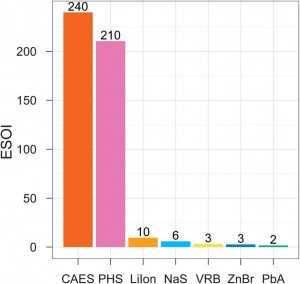A recent study Barnhart and Benson introduces a new analytical method to quantify grid energy storage (hours vs. minutes) technologies, using a new metric ESOI (Energy Storage on Invested). This metric considers round-trip efficiencies, lifetime, and the energy and material demands to manufacture the technology. This metric can help predict costs.
Mechanical technologies like Compressed Air Energy Storage (CAES) or Pumped Hydro Storage (PHS) have a much higher ESOI than Electrochemical Technologies. While mechanical technologies typically require geologic formations to provide potential energy storage (underground caverns for CAES or dams for PHS), there are several promising new start-ups developing technologies that are much easier to site: Gravity Power, SustainX, and Advanced Rail Energy Systems.
There is interest to take Li-ion batteries from the automotive industry and apply them to energy storage – either packaged arrays of new batteries or even used BEV batteries. While the automotive and consumer industries are driving Li-ion batteries to higher power and energy densities, and lower costs, grid energy management storage also requires higher cycle life and high material availability to have a higher ESOI.
I like the new metric ESOI as it forces us to analyze technologies with the critical material and energy inputs in a systematic and quantifiable method, and can help compare alternate technologies.
Reference: Charles J. Barnhart and Sally M. Benson (2013) On the importance of reducing the energetic and material demands of electrical energy storage. Energy Environ. Sci., doi: 10.1039/C3EE24040A

